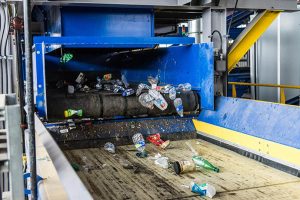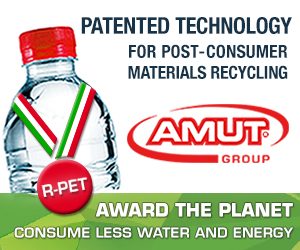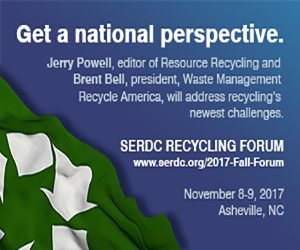 Operators of materials recovery facilities are increasing their labor forces and installing additional sorting equipment in response to Chinese restrictions on scrap imports. As companies increase sortation efforts to create a higher-quality output, attention is also turning to the domestic plastics processing market.
Operators of materials recovery facilities are increasing their labor forces and installing additional sorting equipment in response to Chinese restrictions on scrap imports. As companies increase sortation efforts to create a higher-quality output, attention is also turning to the domestic plastics processing market.
Four materials recovery facility (MRF) operators and a plastics recycling expert were among the speakers on an Oct. 19 webinar hosted by The Recycling Partnership. The webinar, which drew more than 500 listeners, broke down how different MRFs in different regions of the U.S. are being impacted and are responding, as well as what the changes mean for the future of domestic plastics recovery.
Input quality is key
Bob Cappadona, vice president of Casella Recycling, said his company has added workers on the tip floor, on the sort lines and near the balers to inspect for quality.
Casella has six MRFs in the Northeast, and they are increasingly breaking bales to ensure maximum quality. There has been a renewed focus on the quality of material entering the MRF, Cappadona said, with workers looking at every load on the tip floor.
“It is very difficult to make a good quality product … without a quality input,” he said.
Equally important, Casella is ensuring its sort lines are running at their designed tons-per-hour throughput.
“There’s no sense in running it any faster, which takes discipline,” Cappadona said. It can be a hard call, he added, particularly when material is stacking up on the tip floor. But if equipment is pushed over its designed throughput, “you have quality issues, you don’t have pure separation, so it affects it downstream,” he said.
Casella has seen slow movement of material, he said, particularly on the fiber grades. The materials formerly bound for China are now heading to Thailand, Indonesia, India and other countries, and some material has been pushed domestically.
“It always starts with quality but it always ends with price.” — Hilary Gans, South Bayside Waste Management Authority facility operations contract manager
The biggest impact has been the sharp decline in commodity values, Cappadona said, describing a 50 percent decline in the value of the single-stream ton as a whole.
Inspections increase
From Northern California, a public waste management agency described erratic movement of materials and drops in plastics and fiber pricing. The South Bayside Waste Management Authority (SBWMA) is storing materials more than usual due to the inconsistent ability to move shipments, said Hilary Gans, the agency’s facility operations contract manager.
The SBWMA is a joint solid waste agency with a dozen member municipalities around the San Francisco Bay Area.
Gans said many MRF operators in Northern California are in a similar position. He also described reports of companies filling warehouses with bales in Long Beach, a major fiber exporting port in Southern California.
Gans said the agency doesn’t plan to landfill materials unless it is strongly pressed to do so, noting that it creates a public relations problem for any recycling program. But if the mixed plastics market doesn’t stabilize, he said, the agency might consider removing some of those materials from its list of collected recyclables.
The agency has hired more sorters and is inspecting 1 in 10 bales, Gans said, to maximize quality.
He described the dramatic drop in pricing for recyclables since China made its announcement. The agency has adjusted its budget based on the Chinese policy changes, Gans said, as it has in the past during periods of heightened focus on quality.
“It always starts with quality but it always ends with price,” he said.
New equipment installations
Bill Keegan, president of Dem-Con Companies, which operates a MRF about 20 miles outside Minneapolis, said his facility is slowing down sort lines in response to the policy changes. That results in less production and higher labor costs per ton. He said the region has an increased need for processing capacity since it has slowed lines.
“Tonnages that were processed at a facility easily previous to the National Sword are now being moved over to even competitors’ facilities that have excess capacity just to handle those volumes,” he said.
Dem-Con has looked to hire more employees but has had trouble doing so, Keegan said, pointing to the 3 percent unemployment rate in the region as a challenge. In response, the company has begun looking toward automation. The company has added an optical sorter in the past month, he said, and is also experimenting with adding robotics to its line. Resource Recycling previously wrote about a carton-sorting robot the company has installed at its MRF.
Dem-Con has seen some of its markets dry up due to China’s policy changes, Keegan said, particularly for film.
“We’re working with municipalities to communicate that, so they don’t continue to increase the variety of items in the bin when we’re having challenges moving the standard items that we’re seeing in there,” Keegan said.
The changes have also led to an increased focus on contractual negotiations, Keegan said, particularly ensuring the company’s contracts with municipalities are more transparent and sustainable and share the risk between both entities.
“When we’re not seeing that in an RFP, we’ve recently just not bid contracts,” he said.
“We kind of have a chicken and the egg problem where it’s hard to justify infrastructure investment sometimes when we’ve had demand from an export market.” — Nathan Jeffay, More Recycling sustainability consultant
Driving up domestic demand
With material movement slowing, domestic markets have received renewed attention as potential downstream outlets. Nathan Jeffay of More Recycling examined how much material is exported and how much domestic processing capacity exists today.
The results vary widely based on the resin. Looking at figures for 2015, Jeffay noted 28 percent of plastic recovered in the U.S. was exported. But by materials and resin types, 52 percent of film was exported, while just 11 percent of HDPE bottles were sent out of the country, as examples.
For PET and HDPE bottles, U.S. reclamation capacity currently exceeds domestic collection, according to figures from More Recycling. But on the non-bottle rigids and film side, collection exceeds processing capacity, hence the reliance on export markets.
“With that, we kind of have a chicken and the egg problem where it’s hard to justify infrastructure investment sometimes when we’ve had demand from an export market … ,” Jeffay said.
The non-bottle rigid stream is made up predominantly of polypropylene, Jeffay said, with more than 511 million pounds of PP recovered in this stream in 2015. HDPE is the next largest, with 405 million pounds collected the same year.
PS has strong domestic markets, although isolating it into its own stream presents a challenge, as does foam PS requiring densification. PP presents the strongest potential for growth in the rigid plastic reclamation market, due to the amount that’s collected and its value as a feedstock.
“When it can be separated out from those 3-7 bales, tubs and lids, caps, even some of the bottles … that is highly valued material,” Jeffay said. He noted that “the more segregated this material can be, the stronger the market is.” That means relying on secondary sorting facilities, or plastics recycling facilities (PRFs), to isolate PP from mixed bales and provide the valuable stream for reclaimers, Jeffay said.
More stories about markets
- Analysis: Import tariffs could support struggling PET
- Aduro loss widens as pilot plant nears commissioning
- Report shows $5B in materials saved from landfills



